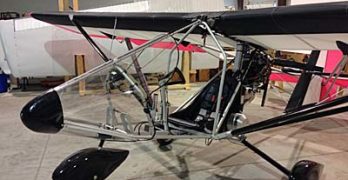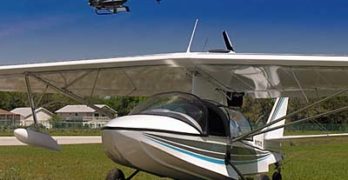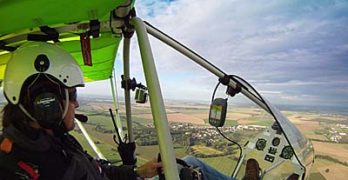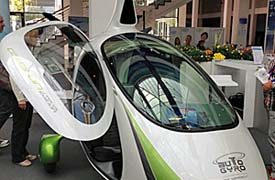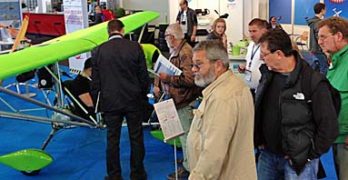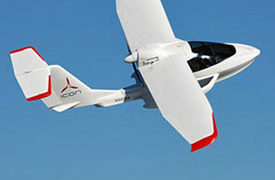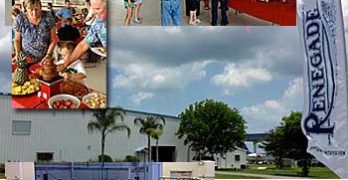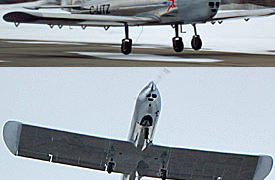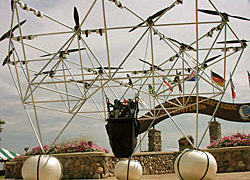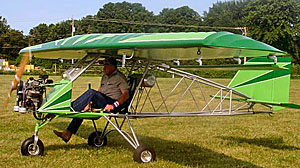Some people have long believed that Part 103-legal weight shift trikes or single place powered parachutes may be possible but I’ve often heard the pronouncement, “You cannot make a legal three axis Part 103 airplane.” I wonder if those folks are ready to admit their error?
Those attending the 2015 Sebring Expo will want to examine the new Aerolite 103 with a Briggs and Stratton four stoke, all freshly mounted and looking better than ever. That you can fly such an airplane without a pilot’s license or medical, without N-number registrations, and buy one ready-to-fly for an affordable price amazes more than a few pilots. However, mostly those machines — a few have been available for some time — use two stroke engines in order to stay within the very confining 254 pounds of empty weight. If you don’t care for two stroke power …Wait no more!
You might remember seeing such a machine at Sun ‘n Fun 2014.
Search Results for : Aerolite
Not finding exactly what you expected? Try our advanced search option.
Select a manufacturer to go straight to all our content about that manufacturer.
Select an aircraft model to go straight to all our content about that model.
Fresh American LSA & Ultralight Exports
Wait! “…Exports?” I realize that might look like a typo. Did I intend to write LSA imports? Nope, exports is the correct word. Back in the early days of Light-Sport Aircraft, circa 2005-6-7, the source countries manufacturing the LSA people were buying were of a high percentage European with the Czech Republic leading the charge. Their penetration of the market was approximately two-thirds of all LSA. Then came the global economic recession, which happened as the industry began to mature. All were affected: domestic and international companies and pilot consumers. Some handsome imported aircraft never found a market.
In any downturn, some managers adapt quicker to the changing economy. They find a way to offer new aircraft to keep the momentum. Neither were American companies sitting on their thumbs. European builders had a head start because the European-style ultralights they had been manufacturing were close to what FAA allowed as LSA, so many models could be rapidly adapted to meet the Yankee marketplace.
Light Is Right In the Eyes of FAA and World CAAs
Evidently, a magic number exists to authorities in various civil aviation agencies around the developed world. That magic number — more correctly a range — is 115 to 120 kilograms, or 253 to 264 pounds. FAA led this charge way back in 1982 with the introduction of FAR Part 103 codifying that an airplane, ‘er … “ultralight vehicle” with an empty weight of 254 pounds — subject to certain exceptions for emergency airframe parachutes or float equipment — could be flown without three requirements common to all other aircraft. Part 103 vehicles• do not require registration (N-numbers); the pilots of these ultralights need no pilot certificate of any kind; nor do they need a medical. Such aircraft can be sold fully built, ready to fly. The entire regulation governing their use can be printed on the front and back of a single page of paper. This simply must be one of the most remarkable deregulatory efforts in all of aviation.
Aero 2014 Review … Starting to Think AirVenture
Life has settled down a little after the rush that began at the end of March. Five weeks back, Sun ‘n Fun was approaching to kick off the season of recreational flying.
Aero in Germany followed with only a one day break before boarding the airliner to Europe followed by plenty of follow-up and contemplating the hot and fast action. With a couple weeks of perspective and to answer a common question — How does the industry look in Europe? — I have some final observations.
I found five areas to consider and list them below. Among all the many wonderful aircraft I saw, two particular subgroups stood out for me personally, one for its sheer success and the other for its subtle return to a higher interest plateau.
I refer first to gyroplanes and secondly to, well … what to call them? How about simply “ultralights?” Even that word isn’t right because Ultralight in Europe means something quite different from ultralight (vehicle) in the USA.
Surprise Star of the Show at Aero?
It depended on whom you asked. As in the United States some were skeptical at Aero. “Oh, this will go nowhere.” “No one is interested” “We tried this and it didn’t work.” Maybe these naysayers are right, but the activity at one booth (or “stand” as they prefer in Europe) seemed to powerfully counteract that doubt. The stand was the Hirth exhibit which featured a variety of aircraft using the German powerplant. The one and only American aircraft example in the Hirth exhibit — indeed, perhaps the only light aircraft at Aero that was Made in the USA — was the Aerolite 103, or as it has been renamed here, Aerolite 120. Why the different name and why the strong interest? To clarify, by strong I mean an airplane sometimes so surrounded by attendees that you could not even get close. As further proof, Aerolite 120 was written up by several publications during the four days of Aero and also garnered television coverage.
Light Aircraft Weight … More or Less?
Several aviation sources recently carried news about Icon Aircraft and their A5 LSA seaplane development. Icon Aircraft has been waiting — surely with increasing impatience — for FAA to answer their formal request for exemption to the Light-Sport Aircraft gross weight parameter. FAA normally replies in 120 days, however, more than a year passed and all that arrived was a request for more detail. One can imagine the cries of angst at Icon. Many have wondered when (or if) this handsome aircraft will go to market but if you were part of their leadership, what would you go into production with … a 1,430-pound seaplane or one at the new requested weight of 1,680 pounds? Either way, what if FAA later changed their mind about an exemption they might grant. Recent news about the IRS makes us all aware government agencies don’t always operate as we expect. What a vexing situation for Team Icon.
Renegade Open House; Phoenix Award; More Videos
Several Florida airports have been active during the recession in their efforts to pull new clients. We reported earlier such projects but went to visit one of these over the last weekend. Renegade Light Sport Aircraft had an open house staged in their gargantuan 71,000 square foot hangar and offices on the Fort Pierce airport. Perhaps 200 attended and enjoyed proprietor Doc’ Bailey’s expertise with the barbecue grill. Certainly the facility is mighty impressive as a base of operations. Besides vast square footage, climate controlled work areas are available as is a paint booth and drying kiln. Renegade will be some time filling this large space but Doc’ reported a very special price offer with owner financing that compelled him to move from rented facilities in Missouri. Meanwhile we reviewed projects for the Lil’ Rascal carbon fiber version of the Pitts S1 to plans for the first all-American-built Falcon.
March 2013 LSA News Wrap
Several news items in our March 2013 LSA News Wrap and we’ll get to it … right after this: We’re thrilled to tell you that — for the second month in a row — ByDanJohnson.com achieved another record. Despite fewer days, February substantially exceeded January’s Unique Visitors, reaching another all-time traffic mark. Last year was amazing and 2013 is even better. THANKS so much for your regular visits and welcome to our new readers!
Sam LS Flies — Pilots love new developments, so aviation media outlets jumped all over the first flight of Thierry Zibi’s Sam LS. The retro-looking, all-metal Light-Sport candidate (it has not yet gone through the Special LSA process and will initially be sold as a kit) attracted plenty of attention at the Sebring Sport Aviation Expo where the company bought a premium position just inside the main gate. By Sun ‘n Fun in less than one month, Thierry will hit another benchmark as the aircraft flies for the public.
LSA & Lightplane Highlights at Oshkosh 2012
In the near future, we’ll present fuller stories of some of the following short bits from Oshkosh 2012. With UltralightMews, we shot videos on most of the following, too, so watch for those as we can post them. Enjoy!
CESSNA & PRIMARY CATEGORY Early on in the week, Cessna announced they would transition their LSA Skycatcher to Primary Aircraft status. That requires a Type Certificate and FAA production approval but the Wichita giant can do this handily even if will add some cost. More on in a later article. However, here’s a way Cessna can recapture some 80 orders from Europeans cancelled earlier this year. On a more fun note, it was a pleasure to meet all nine of their youthful ambassadors that worked in the Discover Flying Challenge program. We shot a video featuring each participant and we’ll post that as soon as possible. (In the near future, we’ll feature a brief review of Primary Category versus LSA.)
AHOY, AKOYA!
Not Your Average Backyard Flyer
One of my joys at AirVenture 2011 was visiting a seemingly revitalized Ultralight Area. Though a shadow of its former self in the 1980 heydays, new life seemed to be springing up, whether through electric powered aircraft or affordable Part 103 fixed wing designs.
Proving the naysayers wrong (again!) were at least two intriguing Part 103 airplanes you can buy and fly today for less than $20,000. That’s well the under the average price of a new automobile for a ready-to-fly aircraft with desirable features, not a stripped-down machine that no one really wants. I wrote about Terry Raber’s lovely little Aerolite 103. A day after looking over his work, UltralightNews and I shot a video review of the Valley Engineering Backyard Flyer. Once again, I had my eyes opened.
If you’ve ever visited AirVenture’s Ultralight Area, odds are you saw a pilot known as the “Flying Farmer” doing circuits of the Ultralight Area pattern.
- « Previous Page
- 1
- …
- 4
- 5
- 6
- 7
- Next Page »


